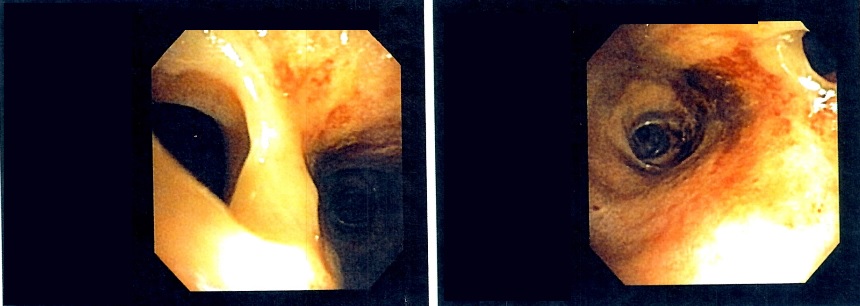Case Presentation:
A 50-year-old Caucasian male presented with complaints of worsening shortness of breath, cough productive of thick, yellow colored phlegm and fever for three days. His past history was significant for adenocarcinoma esophagus requiring subtotal esophagectomy with upper gastrectomy and anastomosis along with chemotherapy and radiation four years ago. Prior to admission he was started on prednisone and levofloxacin without any improvement. On admission, pertinent examination findings included dropping oxygen saturations and diffuse coarse breath sounds with bibasilar crackles. He was maintained on 10L non-rebreather mask. Laboratory data revealed white blood cell count of 16,300/mm³ with 18.3% bands. On review of his medical records it was discovered he had been treated multiple times for recurrent pneumonia. For further evaluation, a computed tomography chest without contrast was performed showing bilateral lower lobe consolidation for which he was started on appropriate antibiotics. Unfortunately, no improvement was noted and patient developed respiratory failure requiring intubation and mechanical ventilation. Bronchoscopy revealed GBF of the right mainstem bronchus just below the carina with slight hemorrhagic area below the fistula reflecting inflammation from acid aspiration.
Discussion:
GBF must be suspected in patients post esophagectomy presenting with recurrent pneumonia. Other risk factors include perigastric abscess secondary to gastric ulcer perforation, subphrenic abscess, neoplasm and bariatric surgery. These patients are at high risk of acute respiratory failure. Upper GI contrast study and bronchoscopy are the most useful means of diagnosing GBF. Nasogastric decompression, gastric acid suppression, and infection control are the initial steps of treatment. Surgery is the definitive treatment, however, the type of surgery depends on the severity of the sepsis and the size of bronchial defect. Cervical esophago-gastrostomy with repair of bronchial defect and esophagogastric reanastomosis later is considered in severe intrathoracic sepsis. In less severe cases, simple fistula division with or without resection of lung segments can be considered. For large defects, intercostal muscular flaps can be used for repair. The prognosis in acute severe cases is poor inspite of surgery.
Conclusions:
Gastro-bronchial fistula (GBF) is a very rare, but potentially fatal condition in patients following esophagectomy for cancer. Our case highlights GBF to consider as a cause of recurrent pneumonia in patients with esophagectomy.
